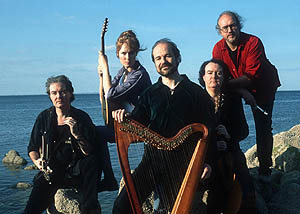
Thomas Loefke et al "December Journey"
Norland Wind "Harp Music from the ..."
"Clannad Connections"
Norland Wind "Atlantic Driftwood"
Norland Wind, Münster, 2003
Norland Wind, Zeltik Festival 2004
Norland Wind "From Shore to Shore"
FolkWorld Issue 34 11/2007; Article by Walkin' T:-)M
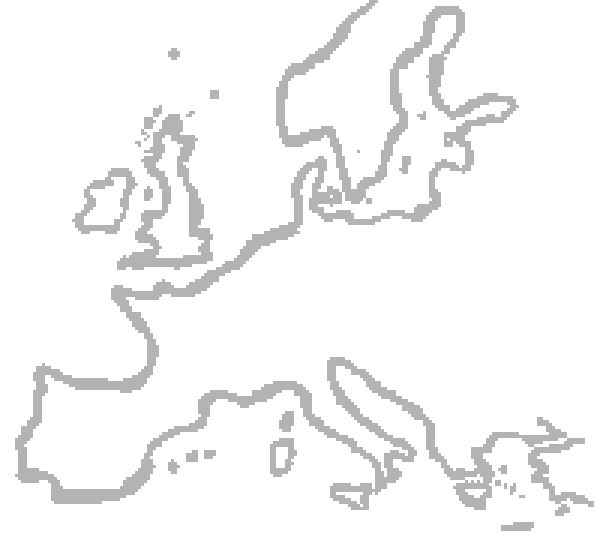

A Decade of Folk
Irish Music in Germany
For years German audiences and musicians alike have been infected with the Irish music virus. Did I say years? Decades, centuries actually! The German-Irish love story may begin with the Irish missionaries and the origin of Gregorian chant.
|
Cut in the forests, swept down the 2-horned Rhine Our keel, tight-caulked, floats upon the sea ... (after St. Columban, ~ 610 A.D.) |
In the 19th century many Germans supported the Fenian cause and tenors sang Irish rebel songs. One of the first commercial recordings of traditional Irish music featured the melodeon playing of John J. Kimmel in 1903, a New Yorker of German stock. Uilleann piper Sean Dempsey performed at the Olympic Games in Berlin in 1936; legend has it that there was no chair available and Dempsey played while seated on the back of an SS officer. During World War II German radio broadcast Nazi propaganda in Gaelic to neutral Ireland and a German male voice choir was overheard singing Irish songs phonetically.
More recent interest arose in the 1970s. The Dubliners, Clannad, the Furey Brothers and the Sands Family criss-crossed the country and Germans, long deprived of their own traditional music for various reasons, fell deeply in love with the rural sounds and rhythms.
Folks grabbed acoustic guitars and Aran sweaters and banged away ditties such as 'Molly Malone,' 'The Wild Rover' or 'Whiskey in the Jar.' While bands playing Irish music sprang up all over the place, it had not been very popular with music critics. How can you do that, they were questioning the musicians, and first-class performers were blamed for second-rate artists. The folk club in Muenster complained in 1976: There is something wrong with Irish folklore. It is very popular indeed. However, cliché groups called Irish Mist, Wild Geese, Tara, or whatsoever, are only the visible parts of a rotten tooth that has to be pulled out.
Most German bands of that decade have been long forgotten since. However, some of its members are still in the business, one way or another. Mandolin player Rainer Zellner went on to form the Music Contact agency, best known for its annual Irish Spring concert tour. Uilleann piper Petr Pandula formed the Magnetic Music label and agency. He is in charge of the Irish Folk Festival tour and is based in Doolin, County Clare, for a couple of years now.
Fiedel Michel went full circle when recording their last album in Dublin’s Windmill Lane studio in 1981. Musical support came from uilleann pipers Paddy Moloney and Davey Spillane as well as saxophone player Keith Donald. An interesting band was rehearsing in the basement, they still remember with a smile, whose members had so curious names as Bono Vox or The Edge, and they were permanently borrowing our guitar amplifyer ...
That curious band soon became worldwide known as U2. It might be called a sign of the times. In the 1980s new wave and punk music swept the country. Folk music was on the decline. But in came The Pogues and with it their irresistible folk punk crossover.
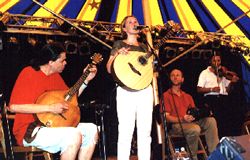 Dereelium "Millvalley" |
Many German musicians still follow the beaten tracks of the Pogues’ folk rock or the Dubliners' pub folk. Irish theme pubs are attracting a young audience with a liking for shamrocks, stout and having a good time. But the 1990s also saw a renewed interest in traditional music. Some artists dug deeper for the roots of the music and took up fiddles, flutes, banjos and bouzoukis instead of the odd guitar. They were travelling to Ireland to learn from the masters themselves. Sessions, workshops and regular meetings for pipers and concertina players became commonplace.
Harpist Thomas Loefke from Berlin assembled an impressive cast and founded the German-Irish supergroup Norland Wind, featuring twin brothers Noel and Padraig Duggan of Clannad fame and fiddler-singer Máire Breathnach on the Irish side. While Norland Wind’s sound is mainly inspired by the music and folklore of County Donegal, there is a charming German and Scandinavian touch to it. Dereelium from Hanover was clearly modelled on the Bothy Band. Finbar Furey once was asked, why he played that fast. Because I can, he answered, and so did Dereelium. The band was top-notch for a couple of years. Dereelium only recently called it a day, but its members sought and found new playgrounds.
An Tor is the Gaelic word for a steep, rocky height. It is a townland four miles south of Croithlí in County Donegal. Furthermore, it is the name of a German group based in the Frankfurt/Main area playing traditional Irish music who are ascending to musical heights. Literally.
Guitarist Marcus Metz remembers: In 1994, Nils and I were travelling throughout Ireland. By chance we met Greg in An Tor in the Donegal Gaeltacht.
Greg afterwards moved to the Rhine-Main area and we did a couple of private functions as a trio under the name of An Tor. In 1996 we got to know Elke, Siggi and Klaus at sessions in Mainz and Wiesbaden. Since 1997 we perform as a six piece band.
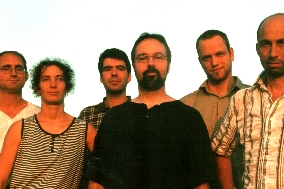
An Tor "Buds in Winter"
An Tor "Craig of Dawn"
"Der Ruf des Nordwestens"
The very beginnings of An Tor do not only lie in the region of the same name, but in traditional music from Donegal music in general as we shall see later on. However, Marcus chuckles, our aim is simply playing music, having fun with each other, and let other people share our joy as well. So who are these five merry men and one woman from Germany with a strong attraction to the north and north west of Ireland?
Marcus Metz is the guitar player of An Tor. From 1991 to 2001, he and flutist-singer Nils Nolte played in a quite well-known Irish folk band called The Hibernians. Bouzouki player Klaus Feketics and button accordionist Greg Ostermann played Irish music in a couple of different outfits. Fiddlers Elke and Siggi Zoerntlein did the same. They also perform French and Breton dance music, at present with the group Pas de quoi. All of them learned their trade and they chose exceptional players and teachers. Flutists such as Marcus Ó Murchú, Gary Hastings and Éamonn Cotter, fiddlers Ben Lennon and Paul O'Shaugnessy, accordionists such as Patsy McDonagh, Dermot Byrne, Peter Browne and Derek Hickey. They accordingly feel obliged to pass on the music in workshops all over Germany.
What music inspires An Tor? For sure, everybody of us is inspired by the music he listens to. Marcus cites Christy Moore, Clannad, Planxty and The Bothy Band. The tunes mainly come from Irish musicians and sessions. The songs rather come from recordings or books. We don’t want to play too much tunes that had been recorded too often. We stimulate each other, because we oftentimes take up and develop ideas which one of us came up with.
This becomes evident listening to their recent album 'Craic of Dawn'. If only for the strathspey-highland-reel succession 'Lord Seaforth' (named after the Mackenzies of Seaforth, the last Lord having been lamented by Sir Walter Scott) / 'Jimmy Lyons' (not to be confused with the American jazz saxophonist, he had been a fiddler from Teelin in Donegal) / 'The Hare in the Corn' (associated with the famous itinerant fiddler Johnny Doherty).
The songs also have their origins in the north of Ireland. 'The Verdant Braes of Screen' – in between a zwiefacher which is a common Bavarian dance tune – is best known sung by the McPeake Family from Belfast. 'I Courted a Wee Girl' has been made quite famous by Sligo group Dervish, who themselves heard it from the singing of Sarah Makem from County Armagh. 'The Gem of the Roe' is related with the O’Cahans of the Roe, northern Irish chieftains and princes who possessed extensive lands bounded by the rivers Bann and Foyle. But An Tor are open-minded. They also recorded jigs and slides and a couple of self-composed waltzes. 'Sweet Jenny of the Moor' is a traditional English song with variants all over the world. 'She is Like the Swallow' comes from Newfoundland.
We don’t want to compare us with Irish groups, Marcus says with slight hesitation. There is no need to hide, 'Craic of Dawn' eventually catapulted the musicians among the top players in Germany. So let us better talk about what differs An Tor from other German groups. Maybe a difference is that we don’t even try to put together perfect arrangements, but leave some space for the single musicians. Another difference might be, as already pointed out, that we don’t take ourselves too serious. We laugh a lot on stage and this communicates to the audience. If you’d notice that the band on stage hasn’t a good time, you couldn’t enjoy yourself. Concerning An Tor, there is always a lot of humour going on. And the craic is mighty, which is a good attitude after all while ascending to the top.
There had been emigration from the Pfalz (Palatinum) to County Limerick in the early eighteenth century. All that is left today is a heritage centre in Rathkeale’s old railway station, unusual place names like Pallas Green (Pfälzer Grün) and descendants such as poet Gabriel Rosenstock or bodhrán player Tristan Rosenstock. At least, according to their surnames.
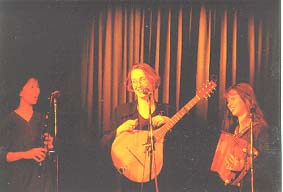 "More Maids in Büttelborn" |
At the early age of six Gudrun took up the violin, later she also learned to play the hurdy gurdy and the accordion. With Irish and French folk music being her staple diet, Gudrun remembers, since her elder brother was playing the box as well as French bagpipes. Gudrun was only seventeen when she formed her first band: More Maids! The group began its life at a Poozies concert in Germany. They could not find a German equivalent to the all-female Scottish band. Thus Gudrun, together with Marion Fluck (flute) and Barbara Coerdt (bouzouki), just founded it. Gudrun became a professional musician soon after.
Since 1996 More Maids recorded several albums and toured the continent. The Maids became a favourite with folk music promoters. Not only being three lovely lassies, they were pretty good. They were inventive, if not to say, innovational. The Maids were not only picking the best of the barley, but taking up the roots and writing their own songs and tunes. And they did sound very Irish, at the same time they had a special knack which had to come from outside the Irish tradition. Their mixed bag of tunes showed the variety of Irish music, among them several original compositions. However, their trademark became their contemporary folk pop songs: Robert Louis Stevenson’s 'Shining Clear' (music by Battlefield Band’s Alan Reid), Dougie MacLean's 'Ready for the Storm', songs by Suzanne Vega, The Indigo Girls and The Dear Janes.
When the three lasses eventually took to a slower pace, the next challenge lay behind the corner. In 2003 Gudrun was heading for a bigger orchestra and a bigger sound. What became Cara was familiar to the German-Irish scene: I got to know Sandra Steinort [vocals, flute, piano] from sessions and we thought that our voices fit to each other very well, says Gudrun.
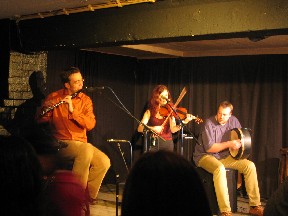 King-Walther-Treyz "3rd Dimension" |
Different backgrounds to build up on the More Maids ideas and go some steps ahead. Everybody brought in his or her particular taste and special ideas, and we got to find the common ground to start from. In the end, it was very good that we have quite different favourites. So a lot of things happened we would never have figured out ourselves, if we all would listen to traditional Irish music only.
Let’s have a look at the tracks of Cara’s 2004 debut album 'In Colour'. The CD includes a couple of traditional jigs and reels, and some self-composed tunes by Jürgen, Claus and Sandra, covering the Celtic fringe from Scotland and Ireland to Britanny and Galicia. However, it is the song department that is Cara’s distinctive feature. 'Three Ravens' and 'False, False' are traditional Scottish songs, whereas 'The King and the Fair Maid' and 'There’s a Light' have been written by Gudrun in traditional style. Finally, 'Sailor Boy' is actually a bluegrass standard with the title 'What Does the Deep Sea Say?' with a new haunting tune.
Gudrun Walther is quite amazed by the response: Cara was welcomed in Ireland with open arms. The audience was very encouraging, even at a big festival with many Irish bands [Ennis Trad Festival in 2005]. We had almost no CDs left at the flight back home. In summer 2007 Cara toured the United States, establishing themselves as the best, most popular and most innovative Irish group from Germany at the time being.
|
Ripples in the rock pool, Ripples in the sea, Ripples in the sand dunes Blowing into Connemara |
... the Irish music group Iontach used to sing. Shaun Davey's song is actually about 16th century pirate queen Grace O’Malley who had been marauding the coasts of Mayo and Galway. However, in days of yore the area where Iontach is based had its fair share of liekedeelers (the local names for buccaneers): Cuxhaven County at Germany’s North Sea coast. The road across the North Sea had always been a short one, extending east to the Baltic ports and west to the Celtic fringe. Fiddler Brian McNeill once found out about it and wrote a mazurka he called 'Danzig Willie', named after German-Scottish trade relations. German-Irish trio Iontach brought together Irish singer and flutist Siobhán Kennedy, her husband, multi-talent Jens Kommnick, and singer Angelika Berns, both from northern Germany.
Siobhán Kennedy grew up in a musical family in Dundalk, County Louth. She started playing flute at the age of 4, later took up fiddle and concertina too. Since 25 years, Siobhán is involved in stage productions and céilí band shows. She had been a member of Gerry 'Fiddle' O’Connor’s group Lá Lugh and performed (and danced) on festivals across Europe.
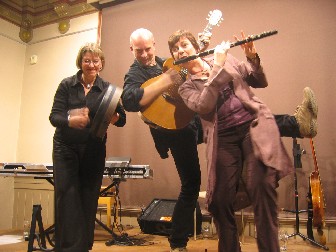 "Stories & Session" |
Jens never had any doubts about playing traditional Irish music, he told me: Do you have to be black to play the blues? Jens neither can see enormous popularity nor met any disapproval from music critics. Normally reviews turn out favourably well which makes me feel quite happy. Iontach’s debut album in 2004 had been nominated for the Folker! magazine’s CD of the Year and critics were glad to point out that it is a dated preconception Germans couldn’t play authentic Irish music. I consider it a gift to be permitted making music that at times touches other people.
I asked Jens how Iontach came into existence? We had been engaged for a musical workshop and made up a small programme for a final concert. After we realised how much fun this performance had been, we decided to continue as a permanent band. There was not much thought about the proper musical style: Our instrumental music is biased on traditional tunes from Ireland, whereas our songs originate from England and Scotland as well. I think that one of our trademarks is the three-part harmony singing, partly delivered a capella.
Questioned about what differs Iontach from other German groups, Jens pauses for a second. Apart from playing Irish music, many groups today – if from Ireland or beyond – are playing tunes from Britanny, Galicia, Asturia, Scotland, Wales and the Balkans. We are primarily dedicated to traditional Irish dance tunes and airs. Furthermore, our harmony singing is a leitmotif in our set. The quantity of instrumental and vocal music is well-balanced.
Jens thinks for another moment. Basically our arrangements – in contrast to those of other groups – are rather subtle, defined by our love to musical detail. Eventually, we prefer unamplified concerts, when the conditions permit.
Their choice of songs demands more than one answer too: Sometimes our interest is awoken by old audio recordings. Sometimes there is a poem that touches us and we put music to it. There are self-penned compositions that we arrange.
At other times there are personal experiences or relationships to musicians and poets, e.g. to our late friend Eithne Ní Uallacháin. In the latter case we felt the necessity that her music lives on and we developed new arrangements to her compositions.
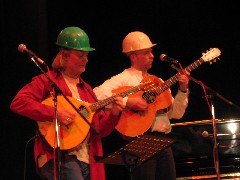
Peter Kerlin "A New Day Dawning"
Peter Kerlin "Hear the Wind Howl"
Peter Kerlin "Dancing Days"
"Ein Fall für zwei ..."
Iontach defies any presumptions about Celtic-Teutonic power folk rock or pub song. Sometimes hilarious and spirited, sometimes melancholic and close to chamber music. The instrumentation is incessantly changing. The singing is rather empathetic, affectionately arranged in three-part harmony. Apart from singing, Siobhán plays flute, whistle, fiddle and concertina. Angelika plays bodhrán and keyboards. Jens plays everything he got hold of, including guitar, bouzouki, mandolin, viola, cello, bass, uilleann pipes, whistle and piano.
Angelika is responsible for the English songs. The traditional Gaelic songs are sung by Siobhán. For example, 'Ding Dong Dederó' from their album 'Jiggin' It' is a working song, the song’s title and chorus probably being the rhythmic sound of a blacksmith hitting off the iron horse shoe. That reminded me that Breandán Ó Madagáin mentioned the smith's song in his book about 'Keening and Other Old Irish Musics'. He bemoaned that not too many work songs have come down to us, since their widespread practice declined before collectors recorded them. Well, thanks to the Germans and their work ethics for upholding the tradition.
In the end I had to ask Jens about the group’s name for all those who have no Irish. Basically we like the self-mockery. Iontach means both ‘wonderful’ and ‘strange’. So we’re always on the right side with the characterisation of our set. Furthermore, the name is pronounceable for most German tongues without any problems. Iontach's aim is very simple. First of all, we like to have fun and joy, and we try to communicate it to the audience when on stage. The best prove had been Iontach’s concert in Vienenburg, Germany, in early 2007. The trio had some mighty craic, as you can seen on the picture above. This pose was not staged, no, they realized that I got out my camera and they made their gimmicks while continuing their set of reels. However, I can assure you, Iontach is no bunch of crack pots either. Siobhán, Angelika and Jens take Irish music very seriously.
There is much more to recommend and to look out for. Garifin from Hamburg, their head Guido Plueschke is determined to turn entire Germany into bodhrán players; Déirin Dé, centred around Dublin singer Ann Grealy; the Irish Trad Heads; Steampacket; Dán. Do not forget neighbouring Austria and Switzerland, and bands such as Squadune and Smoky Finish, Ballycotton and The Bow Triplets.
Germany has been good for some musical extravaganza too.
The German-Irish scene changed a lot during these ten years. In the 1990s Pogues-like folk rock bands were very popular, says Marcus Metz. It seems this is out of fashion. After an enduring time of languish, there are newly arrived groups playing traditional Irish music. The number of people showing up at folk concerts and the number of people attending folk music workshops is not too bad. There are a lot of beginners that want to play the tin whistle, the fiddle or the bodhrán, and there are many fresh faces. This is fine, even if young people are missing somehow. The youngest of the established players are beyond thirty, and the new students are no teenagers either, but forty or fifty years of age when discovering Irish music. However, our own offspring, yet babies and small kids, is growing up with Irish music. Maybe this is the next generation.
Jens Kommnick helds the opinion that the German-Irish folk music scene has developed to the better in the last 15 years. Young musicians, that had been only ten at the time, enrich today’s scene. I think that there never have been so many bands playing Irish music so extremely well as today. For example Cara, but the list can be easily continued.
Gudrun Walther was already heading for a different musical project altogether. Gudrun explains, we were questioned again and again by non-German musicians, what traditional German music sounds like. We knew a couple of Franconian zwiefache [a dance tune] and Palatine ballads. But we felt an urgent need to play some other German songs and we started to research. Gudrun Walther and Jürgen Treyz recorded a CD with traditional German songs and tunes under the disguise of 'Deitsch.' This is dialect for Deutsch, which means simply German.
Gudrun and Jürgen connect to the repertory of the 1970’s German folk music revival.
The selection of songs and tunes is traditional German, but the interpretations cannot deny the musical socialisation of a decade playing Irish music. All the different sorts and styles that we ever played went into it. Be it an Irish sounding ornamentation or a bluesy pattern. But one thing was always important for us. It had to relate to the particular song and it should make any sense in the arrangement. We think that traditional music all around the world always had been revived by new influences that musicians brought into the music. Deitsch started touring and received enthusiastic responses; there is already talk of a new Deutschfolk revival.
There is no doubt, Irish music is firmly established in Germany these days, it is quite alive, it is performed at the highest musical level that has ever been, and more is to come.
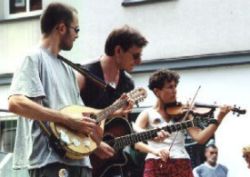 This article is based on a series of features published in the Irish Music Magazine in 2006 and 2007.
This article is based on a series of features published in the Irish Music Magazine in 2006 and 2007.Tom Keller (aka Walkin' T:-)M) is a physicist living in Salzgitter, Germany. He is singer and guitar player with the Irish music group Dun Aengus and member of FolkWorld's editorial board. Visit his website: www.deochandorais.de |
Photo Credits:
(1) Norland Wind (taken from website);
(2) Dereelium (by The Mollis);
(3) An Tor (taken from website);
(4) Dán (by Walkin' Tom);
(5) More Maids (by Marcus Metz);
(6) Cara;
(7) Iontach;
(8) Peter Kerlin & Jens Kommnick (by Walkin' Tom);
(9) Sperris & Wicca (by Sperris & Wicca);
(10) Sasahara Blumenstiel & Tim Rohrmann (unknown);
(10) Deoch an Dorais (by The Mollis).
|
To the German FolkWorld |
© The Mollis - Editors of FolkWorld; Published 11/2007
All material published in FolkWorld is © The Author via FolkWorld. Storage for private use is allowed and welcome. Reviews and extracts of up to 200 words may be freely quoted and reproduced, if source and author are acknowledged. For any other reproduction please ask the Editors for permission. Although any external links from FolkWorld are chosen with greatest care, FolkWorld and its editors do not take any responsibility for the content of the linked external websites.
